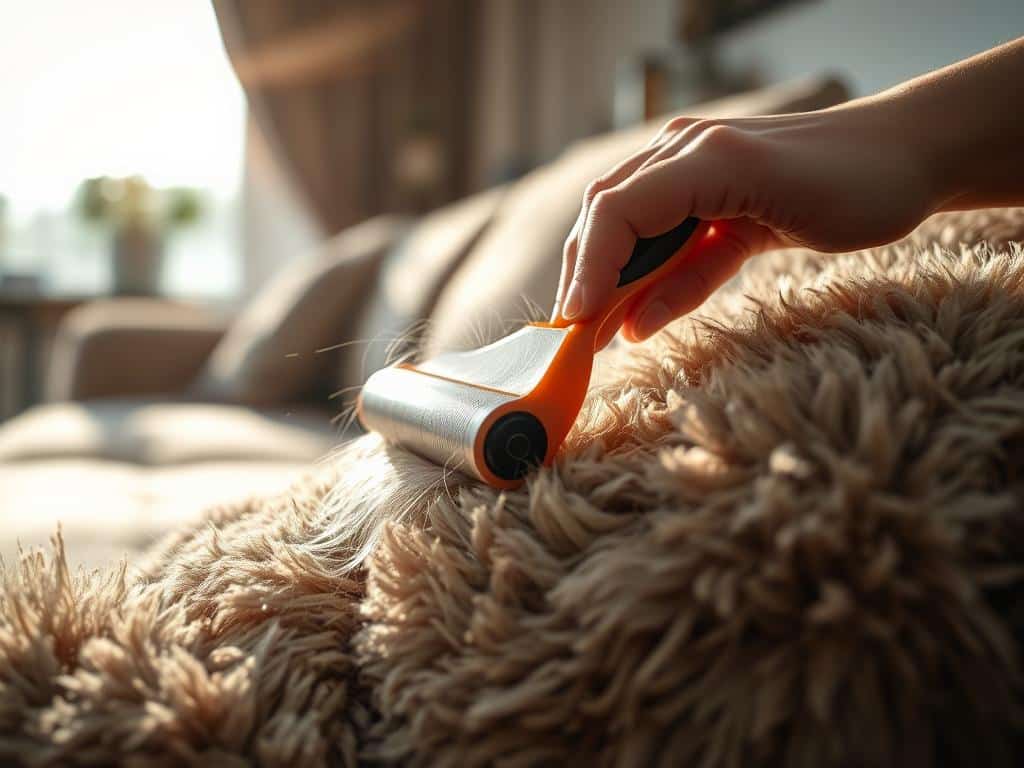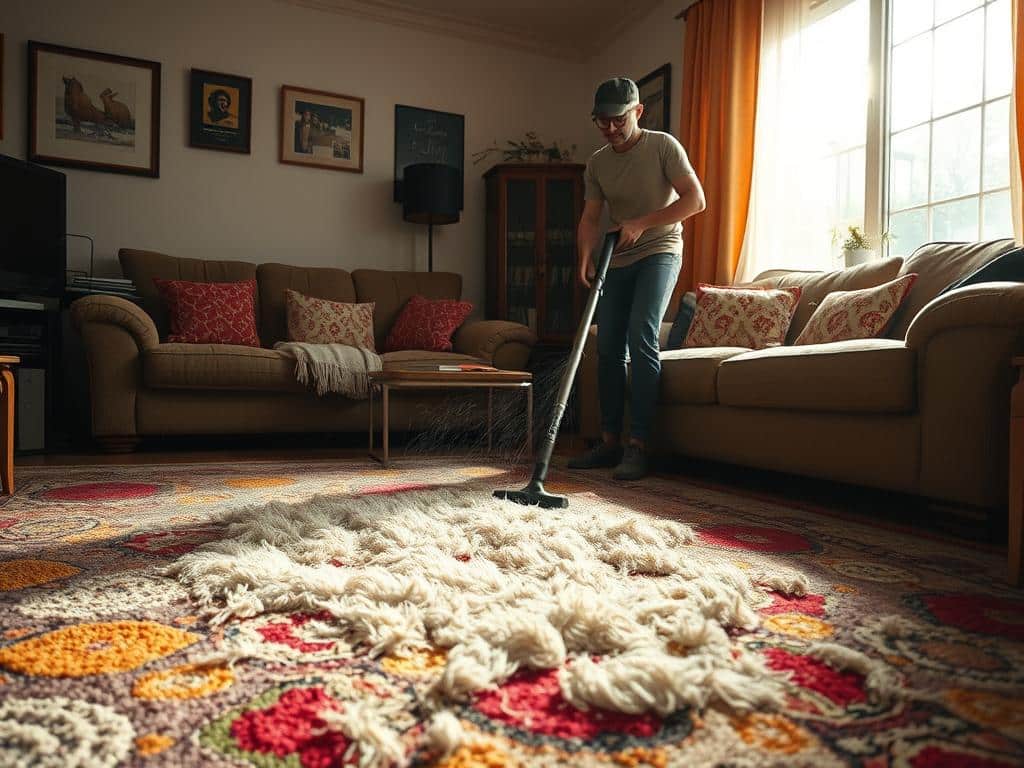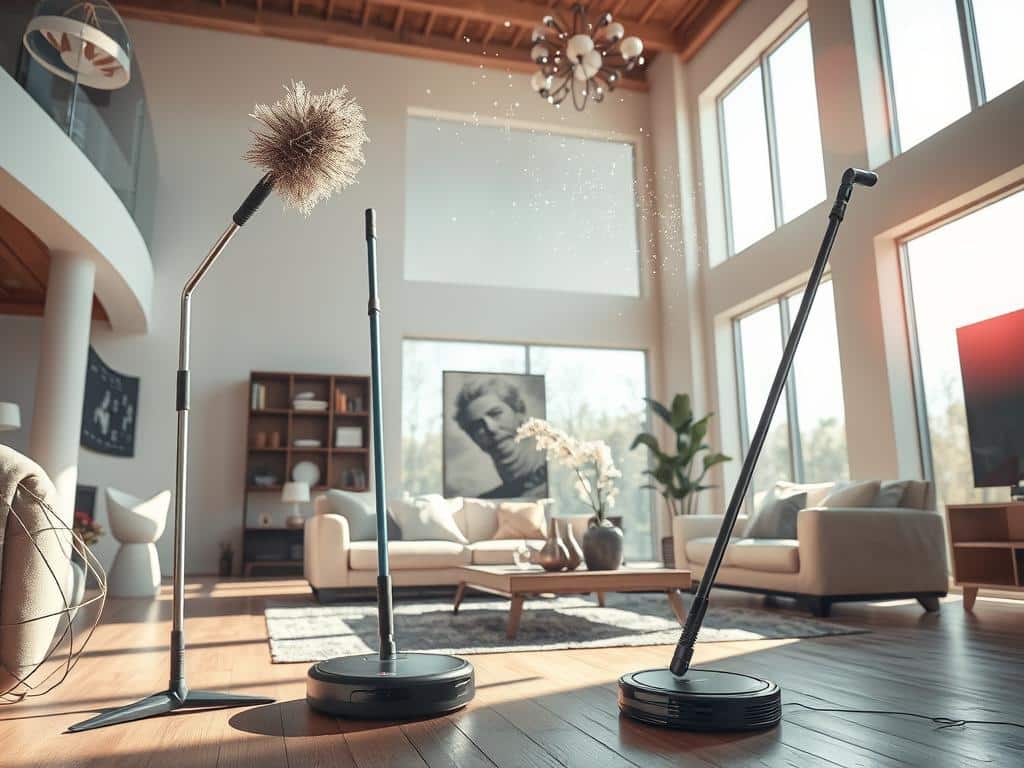
Pet owners often face challenges with pet hair removal due to its pervasive nature. Whether you’re dealing with fur on clothing, furniture, or various home surfaces, adopting effective cleaning strategies is essential. Different surfaces require varying cleaning methods. For example, carpets tend to bind pet hair more easily than hard surfaces like hardwood floors. Effective methods like baking soda on carpets to loosen pet hair and electrostatic dust mops for hard surfaces are helpful.
Cleaning pet hair at home can be simplified using the right tools and techniques. Good brush rollers, detachable wands, upholstery tools, and HEPA filters are important features to consider when selecting a vacuum cleaner. Pet beds are relatively easier to clean as they can be machine washed with pet-safe detergent. For easier pet hair removal, using machine washable area rugs and brushing your pets frequently can be an effective preventative measure. Placing clothes in the dryer before washing helps loosen pet hair, making the laundry process more efficient.
Maintaining a fur-free living space requires a combination of these techniques. Simple tools like a lint roller, vacuum cleaners with specialized features, and eco-friendly cleaning solutions play a crucial role. For more tips on how to remove pet hair from any surface, visit this resource from Martha Stewart.
Effective Methods to Remove Pet Hair from Furniture
Handling pet hair on furniture is a common struggle for many pet owners. The right techniques and tools can make a significant difference in keeping your space clean and fur-free.
Using a Lint Roller
A lint roller for pet hair is a practical and efficient tool. Options like the ChomChom lint and pet hair remover come with textured fabric and rubber strips, acting as a squeegee to trap hair. They are especially effective on upholstered furniture, ottomans, and benches. For larger surfaces, ChomChom implements superior efficiency compared to rubber gloves, eliminating pet hair quicker and requiring fewer passes.
Vacuuming Upholstery
For more thorough cleaning, vacuuming pet hair from upholstery is essential. Utilizing attachments such as an upholstery brush and crevice tool can help reach tight spots like the sides of couches or dining chairs. Investing in a handheld vacuum like the iRobot® H1 Handheld Vacuum with a brush head attachment is advisable. Remember, cleaning removable cushion covers in a washing machine can also reduce fur accumulation.
Anti-Static Spray
Creating a homemade anti-static spray for furniture can aid in removing pet hair. Mix fabric softener, water, and rubbing alcohol, then lightly mist the fabric surfaces before vacuuming. The anti-static spray helps to dislodge pet hair, making it easier to remove. Using this method in conjunction with regular pet grooming can drastically reduce shedding and keep your furniture spotless.
Tips for Cleaning Pet Hair from Clothing
Pet hair on clothing can be a persistent issue, but with the right strategies, you can effectively manage it. Here are some practical tips to remove pet hair from clothes and keep your wardrobe looking fresh.
Pre-Treatment before Washing
Before washing pet hair off clothing, it’s essential to pre-treat the garments. Using a lint roller or washable lint rollers can efficiently remove loose pet hair. If you don’t have a lint roller, sticky tape can serve as a convenient alternative, although it can be time-consuming for larger areas. Vacuuming clothes with a hand vacuum designed for upholstery can also aid in removing pet hair.
Sweeping hardwood floors and vacuuming upholstery regularly can act as preventative measures, minimizing the amount of hair that ultimately ends up on your clothes.
Using Dryer Sheets
Incorporating dryer sheets for pet hair into your laundry routine can be incredibly effective. Dryer sheets help to loosen pet hair from clothing and allow it to be trapped in the lint filter. Before you start washing pet hair off clothing, you might consider placing the garments in the dryer with dryer sheets for a few minutes. This can help dislodge pet hair and make the subsequent washing more efficient.
Wash and Dry Techniques
When it comes to washing pet hair off clothing, using specialized machines like the Maytag® Pet Pro washer—which claims to remove five times more pet hair—can be a game-changer. The Pet Pro Filter option is particularly effective when combined with the traditional agitator washer cycle. Results may vary depending on the fabric and type of pet hair.
After the wash cycle, it’s equally important to dry your clothes properly. The Maytag® Pet Pro System dryer, designed to remove pet hair efficiently, can further assist in ensuring your clothes come out hair-free. Don’t forget to clean the dryer’s lint trap regularly to maintain its effectiveness.
Cleaning Pet Hair from Carpets and Rugs
Pet hair on carpets can be a significant challenge due to its tendency to embed deeply into the fibers. A dedicated approach using specialized tools and techniques can effectively address this issue. Start by employing a strong suction vacuum cleaner, such as the Dyson Animal, renowned for its efficiency in handling pet hair removal solutions. Regular vacuuming is essential to prevent build-up, especially with breeds that shed frequently.
For more stubborn cases, consider using a pet-specific brush like the FURemover, which can be particularly useful on rugs with a pile similar to pet grooming tools. It’s recommended to vacuum a couple of times a week, depending on your pet’s shedding patterns and the type of carpet in your home. A pro tip is to create a solution of 1 part fabric softener to 3 parts water and spray it lightly over the carpet before vacuuming. This method helps loosen pet hair, making it easier to remove.

Moreover, regular maintenance with lint rollers and carpet rakes can significantly reduce the presence of pet hair on carpets. The use of rubber gloves can also be advantageous; simply stroke the carpet, and the hair will adhere to the gloves, which you can then rinse off. When dealing with rugs, polypropylene is praised as the best material for pet-friendly carpets due to its resilience and ease of cleaning. If these methods prove insufficient, hiring professional carpet cleaners is a viable option to ensure thorough cleaning rugs of pet hair.
If you’re interested in more ways to keep your carpets free from pet hair, consider checking out additional methods provided in this comprehensive guide. Customized solutions such as dog brushes, squeegees, and professional services come highly recommended for effective pet hair removal.
Here’s a quick comparison of the most effective tools and methods for keeping your carpets clean:
| Tool/Method | Best For | Frequency Recommended | Additional Notes |
|---|---|---|---|
| Dyson Animal Vacuum | Deep Cleaning | Twice a Week | Strong suction for pet hair on carpets |
| Fabric Softener Solution (1:3 Ratio) | Loosening Hair | Pre-Vacuuming | 1 part softener to 3 parts water |
| Lint Rollers | Surface Hair | Daily | Perfect for quick touch-ups |
| FURemover Brush | Embedded Hair | Weekly | Similar to grooming tools |
| Professional Cleaning | Overall Deep Clean | Monthly/Bi-Monthly | Ideal for thorough cleaning |
Cleaning Pet Hair at Home with Simple Tools
Managing pet hair in the home is a common challenge faced by many pet owners. Utilizing simple tools and techniques can make the process more efficient and effective.
Using Pet Brushes
Pet brushes for cleaning are not just for grooming; they can be invaluable for home cleaning pet hair. Regularly brushing your pets can minimize shedding and make it easier to handle hair on various surfaces. The Furminator brush, for instance, is particularly effective at reducing loose hair and dander. Brushing pets outdoors can also prevent hair from spreading inside the house.
Sticky Tape and Alternatives
Sticky tape, such as masking tape, can be a quick solution for picking up pet hair on smaller surfaces. Simply wrap the tape around your hand, sticky side out, and press it against the fabric to lift the hair. For larger areas, lint rollers or adhesive sheets can be more efficient. Some pet owners even use duct tape as a temporary fix, although this should be done with caution to avoid residue.
Sponge and Rubber Glove Technique
The sponge method for pet hair removal involves using a damp sponge to collect hair from furniture and other soft surfaces. Similarly, moistened rubber gloves can attract and clump hair, making it easy to gather and dispose of. This technique is particularly useful for home cleaning pet hair on upholstery and carpets.
| Tool | Effectiveness | Ideal Usage |
|---|---|---|
| Pet Brushes | High | Reducing shedding, cleaning fabrics |
| Sticky Tape | Medium | Quick clean-ups, small surfaces |
| Damp Sponge | High | Furniture, upholstery |
| Rubber Gloves | High | Upholstery, carpets |
Maintaining a Fur-Free Home with Regular Practices
Maintaining a fur-free home is achievable with consistent routines and effective strategies. Key practices include regular grooming, an established cleaning schedule, specific pet cleaning products, and keeping pet bedding clean. These methods help control pet hair, providing a cleaner living environment for you and your pets.
Grooming Your Pet
Regular pet grooming significantly minimizes shedding. Long-haired breeds like Labrador Retrievers and Siberian Huskies, which experience two shedding cycles per year, benefit from daily brushing during these periods. Grooming long-haired or senior cats can also reduce fur around the home. Incorporating brushing and bathing into your pet care routine ensures less loose hair ends up on your furniture and floors.
- Brush long-haired breeds daily during shedding seasons.
- Consider grooming sessions at least once or twice a week for most pets.
- Regular exercise and a balanced diet reduce stress-induced shedding.
- Consult professionals for the best grooming tools for your pet.
Regular Cleaning Schedules
Establishing a regular cleaning schedule for your home is crucial. Weekly cleaning of carpets, upholstery, and other high-traffic areas keeps pet hair from accumulating. Monthly deep cleaning of often-overlooked spots such as baseboards and behind furniture ensures a thorough clean.
| Cleaning Frequency | Areas Covered |
|---|---|
| Weekly | Carpets, upholstery, pet areas |
| Monthly | Baseboards, behind furniture, under appliances |
Specific Cleaning Products for Pet Hair
Specialized pet cleaning products are designed to enhance the efficiency of your cleaning efforts. Use pet hair attachments on vacuums and anti-static sprays on upholstery. These tools make managing pet hair more straightforward and effective.
- Pet hair vacuums
- Anti-static sprays
- Pet hair remover mats in high-traffic areas
Keeping Pet Bedding Clean
Regularly washing pet bedding plays a vital role in maintaining a fur-free home. Pets spend a significant amount of time on their bedding, which can accumulate hair and odors. Ensure to launder your pet’s bedding weekly to keep the hair and allergens at bay.
By integrating these practices into your routine, you can successfully maintain a fur-free home, making it a more enjoyable and allergy-free environment.
Conclusion
Managing pet hair in your home requires an effective combination of cleaning strategies, the right tools, and consistent grooming routines. From furniture to clothing, and carpets to home surfaces, implementing these methods can significantly mitigate the challenge of pet hair management. Begin by using practical tools like lint rollers, vacuum cleaners with pet-specific attachments, and de-shedding tools to keep surfaces clean and hair-free.
To achieve a stress-free cleaning experience, it is essential to incorporate preventive practices regularly. This includes brushing your pets daily to reduce shedding, maintaining a clean environment, and choosing furniture that is resistant to pet hair. Slipcovers or throws can be used to protect your furniture and make clean-up simpler. Opting for hard flooring surfaces such as hardwood, laminate, or tile can also reduce the accumulation of pet hair compared to carpets.
Combining DIY solutions and professional services can offer the best results in managing pet hair. Techniques like using rubber gloves, fabric softener sheets, and damp sponges are effective for immediate clean-ups, while professional services can handle deep cleaning tasks. Additionally, regularly washing pet bedding and using an air purifier with a HEPA filter can help maintain a healthier and cleaner home environment.
Embrace these cleaning strategies, and you’ll maintain a comfortable and welcoming home for both you and your furry companions. By integrating these tips into your routine, pet hair management becomes a seamless and efficient process, allowing you to enjoy the company of your pets without the constant struggle against their fur.



